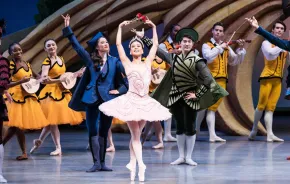
Photo:
Vritika Gupta in SCT's "Black Beauty". Credit: Angela Sterling
What is the power of kindness? Why should you tell your life story, even though there are parts of it you’d rather forget? What does it look like to stand up to cruelty and injustice?
“Black Beauty,” a world-premiere adaptation of the classic children’s novel on stage now at Seattle Children’s Theatre, is the tale of a remarkable horse, but the themes couldn’t be more human.
Brought to life through top-notch acting, magnificent puppets and a brilliant set, the play has some tough moments, but its message of compassion and courage will stick with viewers of any age.

Staging horses
I was curious and skeptical when I heard SCT was doing “Black Beauty.” As a horse-obsessed child, I read the Anna Sewell novel, but though I remember enjoying reading a story from a horse’s point of view, I also remember it as an unrelenting chronicle of how a horse in the 1800s suffered at the hands of humans. I wondered how SCT would ease the story’s brutality for young spectators. And how the heck would they bring a cast of horses to life?
I brought my 9-year-old son and 11-year-old nephew to the play. As we took our seats, the stage provided clues to the horse question. The center of the set was a wooden horse barn, with three stalls. The stalls were dark, but you could just barely make out horse shapes, muzzles and glittering eyes. The figures weren’t alive, but they were awfully horse-like.
The three horses came to life soon enough, and we realized that the “horses” were actually large, very detailed puppets, operated in plain sight by the actors who voiced the roles. Beyond the sheer beauty and detail of the puppets (they are made with a variety of materials, including VHS tape and vinyl), I found their range of expression and movement extraordinary.
Black Beauty's story
As the play opens, it is Black Beauty’s first night in his new home, after having left his mother and the farm where he grew up. An ingenious panel at the top of the barn serves as a screen for the projection of memories and images of time passing during the play. An image of his mother appears, reminding him of her wise words: “Tell your story,” she says. “And always do your best.”
As he tells his new barn-mates, Ginger and Merrylegs, about his childhood, they scoff at his optimism and openness. But they are already developing an affection for this unusual horse with a star on his forehead and one white hoof. He's a horse who has not yet been scarred by life’s travails.
Soon, the three band together to help teach a young boy a lesson. Little Joe is the grandson of their owner, and treats the horses thoughtlessly. So Ginger — known for her temper, with a nickname of “Gingersnaps” — bucks him off. Instead of punishing Ginger, their master teaches the boy to win over the horses with a “secret elixir” of patience, gentleness, firmness and petting — plus common sense.
Over time, Black Beauty’s belief in the boy’s goodness is shown to be true: In the play’s first high-drama scene, a fire in the stable draws the boy to guide two of the horses, paralyzed with fear, to safety. The climax of the scene is heightened by the musical score, played live by a sole pianist, and lighting that shows leaping flames behind the stable wall.
But in the play’s first tragedy, the boy has to leave one of the horses behind.
Black Beauty’s life story continues on from there. After the fire, he and Ginger are sold to a high-fashion “Mistress” who insists that her carriage horses are harnessed with a check-rein to hold their heads high. This is an even tougher scene than the stable fire, as Mistress — acted with hilarious scorn by Hana Lass — demands that her stable man crank the rein tighter and the horses struggle to breathe. Relief comes in the form of revolt: Ginger bites, and the stable man refuses to see the horses suffer further.
Black Beauty’s next chapter is as Jack, a cab horse on the rough streets of London. In one of my favorite staging choices, the puppet is exchanged for a miniature horse and cab, and you see Black Beauty navigating buildings, narrow streets and other “carriages, carts and cabs” in an effort to bring their always-in-a-rush “fares” to their destination. His hard load is lightened by the love of his family, including a girl named Dolly, who is determined to be a horse doctor and bravely takes a stand when she sees horses being whipped. “Cruelty is everyone’s business,” she says stoutly.
Stage notes
The cast includes 14 child actors in two alternating casts of seven; SCT shows typically cast adult actors. My son was interested to see kids his own age performing on stage. As usual, the performances were top-notch, with the professional actors playing several roles. We especially enjoyed the world-weary humor of Merrylegs (Reginald André Jackson) and the spit and fire of Ginger (Annelih G. H. Hamilton).

All that said, the play won’t be everyone’s cup of tea. The play’s flaw is the book’s flaw: It's a little too didactic; has a few too many morals, a main character that’s a little too good. Luckily, flashes of humor and grit along the way leaven the one-dimensionality; in the check-rein scene, for example, the Mistress’s over-the-top performance and puppet dog named Charles add some levity.
And by the time Black Beauty reaches his well-deserved happy ending, the play packs an emotional punch that adults who have been through a few of life’s knocks will especially appreciate.
Parents should know
The play is officially recommended for kids ages 6 and older, but keep the sensitivities of your children in mind. The hardest thing about the play is the depictions of cruelty to animals. Beyond the fire and the check-rein scenes, you’ll see horses being whipped and made to go on, even though they are literally on their last legs. My son, who loves animals almost more than humans, told me he was able to tolerate the hard stuff because, as a staged play with puppets, he knew it wasn’t real. My nephew had a harder time and found the scenes a bit unrelenting. Note that there are also depictions of a near-death experience and drunkenness.
If you go...When: “Black Beauty” is on stage now through Oct. 27, 2019. Special performance dates:
Where: Seattle Children's Theatre is located at 201 Thomas St., Seattle, on the west side of Seattle Center. (Note that there is major construction going on at Key Arena, adjacent to the theater, which is affecting access to Second Avenue and street parking in the area.) Tickets: $15–$45; buy online or at the box office. Ticket pricing update: SCT has introduced tiered pricing this season. This means there are $20 adult tickets and $15 children's tickets available for every performance. Select "value" from the drop-down menu on the ticket page to find these less-expensive tickets, and note there are a limited number available for each performance. There are also tickets at "standard" and "premium" levels. The tiered pricing means tickets are reserved seating rather than general admission. Age recommendation: SCT recommends this show for kids ages 6 and older. See notes above for more guidance. Run time: The show runs one hour and 40 minutes, including one intermission. Show resources: SCT’s active audience guide gives a very detailed description of what happens in the story, and also shares the extraordinary background of Anna Sewell and her book, which sold one million copies after it was published in 1877 and was responsible for the end of a cruel equine practice called the “bearing rein.” You can also find a reading list of horse-related books. And check out this SCT blog post on the ingenuity of the puppets. |











